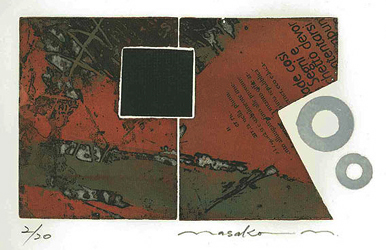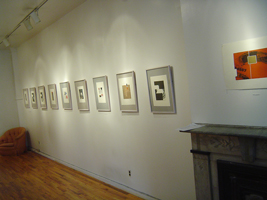
April Exhibition 2005 Printing (Multiple Color Copperplate Print) Masako Miyazaki Tuesday, April 5th, - Saturday, April 23th, 2005 Gallery Hour : Tue. to Sat. 12:00 - 6:00PM |
 |
|---|
In April, Gallery NYCoo features the color copper etchings of Masako Miyazaki. This is an announcement and short critique of the show. Miyazaki works and shows in the Kaisai area of Japan. She explains of how taken she was by the bold expression and color sensibility of childrenfs artwork in the art classes she conducted. Ten years after the establishment of her art program in 1993, she began attending the Osaka municipal art center. She has since exhibited her work and received numerous awards. The works in her first New York one-woman show are mostly collaged multicolored two-dimensional images that are visually reminiscent of attracters. The etching, aquatint, and lift ground techniques are utilized. This is the first time prints are being shown at the gallery. According to Miyazaki, gWhatfs fascinating with prints is that you donft know how itfs going to turn out until itfs printed. I love the thrill I get when Ifm pulling the paper up from the plate.h The excitement particular to printmaking is that it can lead the artist making the print to unexpected realms of which many artists have taken advantage. On the other hand at times, over dependency on the process may foster a lack of assertiveness in imagemaking. This tendency is the same both in Japan and American. However, there is a significant difference between the countries in the attitude of artists making prints and the social recognition of printmakers. Japanese printmaking takes pride in the tradition of Ukiyoe, Sosaku Hanga Movement, avant-garde prints of the 60s and 70s, Japan Print Association, and Japan University Print Association. In contrast, in America, there are the hand colored commercial lithographs such as the works of Currier and Ives until the end of the 19th century, prints by Edward Hopper continuing to those by artists during the WPA period, the works of the 60s which can be described as a renaissance for printmaking, and beyond to those of the various print workshops, post modernism monotypes. Through cultural inclinations and the artistsf own ideas for their works, social recognition differs from that in Japan. For this reason, there is the need for exchange between the two countries, and for Miyazaki as an artist, there is meaning to seeing her own work hung on a gallery wall in another environment. In both cases, it becomes possible to see things that were not visible before which points the way to future explorations. The comments and opinions of those who visit the gallery come to bear more importance.
|
|||
Gallery writer: Hitoshi Nakazato |
|||
